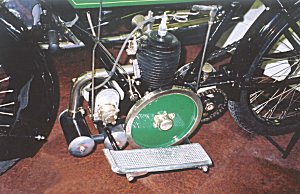The Villiers Engineering Co. Ltd.
From bicycle parts to engines
In 1912 the company was turned in to public limited company,
The Villiers Engineering Company Limited. Why the company was called
Villiers in the first place is not certain. It may simply be that it
was on or near Villiers Street. It may be that John Marston named it
after the long serving Wolverhampton M.P., Sir Charles Pelham Villiers.
Since the street was named after the politician it may be that both factors
were taken into account.
After the free wheel the next vital step in the
development of Villiers was the introduction of the making of petrol
engines. Where the idea that Villiers might do this came from is
not known for certain but Villiers' own publication "Sixty Progressive
Years" attributes it firmly to Frank Farrer. Probably Farrer had made an
assessment of where the future of two wheeled transport might lie.
The story is told by Charles Marston's daughters in these words:
| At Villiers an extremely advanced design was produced
in prototype by an engineer specially engaged for that job - actually it
was an important achievement, but too revolutionary: one Coventry firm
describing it as ‘the engine with hot and cold water laid on’. Privately
at Villiers it was considered also to be too complicated. The machinery
there was not suitable for this kind of work, neither were the necessary
skills available. It was also felt that the future of the motor cycle
lay in the cheap, simple light-weight machine. |
|

The Villiers 269cc engine in a 1922
Sparkbrook motorcycle, at the National Motorcycle Museum. |
The problem then was to find the right type - Farrer
suggested a two-stroke engine, but a conference of experts at first
turned this down claiming that already the two-stroke had been proved a
failure. However Farrer persisted to such a degree that Charles wrote in
the Works’ book, ‘to oblige Mr. Farrer make him a two-stroke engine!’ No
one else was very enthusiastic. |
But the engine was built - unkindly described as a
‘Flying Bedstead’ - and Farrer went to test it. He came back to Charles
jubilant, saying they could sell thousands of these - a complete
understatement as it turned out, for to the Jubilee date (1948) over
three-quarters of a million had been sold. Possibly the very simple
little ‘Levis’ two-stroke, made by Butterfields in Birmingham, inspired
Farrer - who was an expert judge in these matters - to go for extreme
simplicity. It had only three moving parts, viz. a piston, connecting
rod, and crankshaft. ... It was not really a question of ‘pioneering’ a
new engine - Villiers saw the possibility of producing this simple type
of engine at a very low cost thus opening up a large market for very
cheap motor cycles within the pocket of ‘the working man’ of that time. |
|
Farrer conducted his test on the Bridgnorth Road and
the story is that he was so enthusiastic about the engine after this run
that he told Marston that he could "sell thousands of them". In the
end they made well over two and a half million of them.
Production started in 1913 and was an immediate success, but
was interrupted by the First World War, when the firm was making munitions.
The First World War
It seems that there was some production of the
two-stroke engine during the war but the factory was mainly engaged in
making munitions. In any event engine makers were confronted with a
problem in that nearly all magnetos came from Germany and supplied stopped.
Frank Farrer came up with the idea of combining the magneto with the fly
wheel which not only overcame the supply problem but was a success in its
own right, becoming a standard feature of all Villiers engines. The
idea had been tried before but not on a motor cycle engine. After the
war the idea was further developed, especially by the new Chief Engineer,
Frank Pountney. Frank Farrer also looked ahead to the post-war
period and designed and planned the production of new engines ready for
post-war production.
|
 |
|
 |
| Return to the
beginning |
|
Proceed to
1919 to 1939 |
|